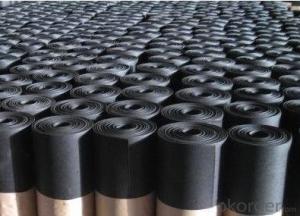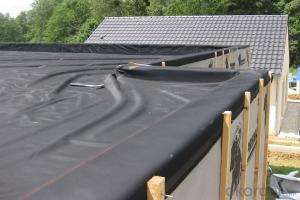EPDM Coiled Waterproof Membrane with 1.2mm Thickness
- Loading Port:
- Shanghai
- Payment Terms:
- TT OR LC
- Min Order Qty:
- 50000 m²
- Supply Capability:
- 5000000 m²/month
OKorder Service Pledge
OKorder Financial Service
You Might Also Like
EPDM Coiled Waterproof Membrane with 1.2mm Thickness
Description Of EPDM Coiled Waterproof Membrane with 1.2mm Thickness:
1. Excellent physical and mechanical performance, high tearing resistance;good deformation adaptability, high puncture resistance;
2. High aging resistance, high UV resistance, anti-acid & alkali;
3. Excellent low & high temperature resistance, innocuous, long life span;
4. Perfect water proof performance, seepage and humidity resistance.
Main Features of EPDM Coiled Waterproof Membrane with 1.2mm Thickness:
A.Polyester based SBS Modified Bitumen Waterproofing Membrane
a. Strong impermeability
b. High tensile strength, elongation, ability to adapt the grassroots shrinkage deformation and cracking
c. Puncture-resistant, broken resistant, tear-resistant
d. The corrosion resistance, resistance to mildew, weathering good
e. Construction convenient, hot-melt can be operated Four Seasons Construction, reliable joints
B. Fiberglass based SBS Modified Bitumen Waterproofing Membrane
a. High tensile strength, stability of a good size
b. High Temperature good performance
c. Damage resistance, corrosion resistance, resistance to mildew, weathering good performance
d. Good construction performance, reliable joints.
Specifications of EPDM Coiled Waterproof Membrane with 1.2mm Thickness:
| Material | EPDM Rubber |
| Size | 1.2m (width)*20m (length) or customized, weldable type 2.05m or 4m width |
| Thick | 1.2mm, 1.5mm, 2.0mm |
| Type | Vulcanized & Weldable |
| Pattern | Non-reinforced (homogeneous) |
| Certificate | ISO9001/14001 |
Applications of EPDM Coiled Waterproof Membrane with 1.2mm Thickness:
geomembrane used in groundsill of road, highway, railway and waterproof layer of swelling clay and wet collapsed loess.Geomembrane can be widely used in areas of garbage burying, waste disposal and underground construction projects.such as below:
- aquaculture ponds
- Ouchi root barrier membrane
- Floating baffles;
- Process wastewater
- Stormwater impoundments;
- Secondary containment;
- Spill containment
- Manure and biogas tanks and covers
- Potable water tanks and covers;
- Sludge Drying beds;
- Bioremediation covers & liners;
- Leachate ponds



IMages of EPDM Coiled Waterproof Membrane with 1.2mm Thickness:




FAQ of EPDM Coiled Waterproof Membrane with 1.2mm Thickness:
1. What are we supplying?
We are specialized in producing Colorful Asphalt Roof Shingle, SBS/APP modified bitumen waterproof membrane, Self adhesive bitumen waterproof membrane, PVC waterproofing membrane, EPDM rubber roofing membrane, Single Component Polyurethane Waterproof Coating, and Spray Polyurea Waterproof Coating
.
2. How Many years experience do we have?
We have been exported to more than 20 countries in the past 15 years.
3. How long do we usually reply your request?
We always reply our customer within 24 hours.
- Q: Can a waterproofing membrane be used in conjunction with fire protection systems?
- Yes, a waterproofing membrane can be used in conjunction with fire protection systems. While the primary function of a waterproofing membrane is to prevent water penetration, it can also act as a barrier to protect against fire. Some waterproofing membranes have fire-resistant properties, allowing them to withstand high temperatures and prevent the spread of fire. However, it is essential to ensure that the specific waterproofing membrane chosen is compatible and approved for use with the fire protection system in question.
- Q: Can a waterproofing membrane be used for swimming pools or water features?
- Swimming pools and water features can benefit from the use of a waterproofing membrane. This membrane is designed to create a barrier that prevents water from causing damage by seeping through. It is commonly used in various applications, such as swimming pools and water features, to keep the water contained within its designated area. When choosing a waterproofing membrane for these purposes, it is important to select one that is specially formulated to withstand the constant exposure to water, chemicals, and other elements commonly found in these environments. Proper installation is crucial to ensure the effectiveness and longevity of the membrane. To determine the most suitable waterproofing membrane for your specific project, it is recommended to seek professional advice.
- Q: Are waterproofing membranes resistant to UV rays?
- Yes, waterproofing membranes are typically designed to be resistant to UV rays. They are formulated with additives and coatings that provide protection against the damaging effects of sunlight and ensure long-term durability and performance.
- Q: Can a waterproofing membrane be used in elevator pits or sump pits?
- Yes, a waterproofing membrane can be used in elevator pits or sump pits to prevent water infiltration and protect the structure from potential damage caused by moisture.
- Q: Can a waterproofing membrane be used in swimming pools or other water features?
- Certainly, swimming pools or other water features can indeed utilize a waterproofing membrane. In fact, it is highly advisable to employ such a membrane in these areas to avert water leakage and potential harm. By serving as a barrier between the water and the surrounding structures, a waterproofing membrane ensures that the water remains contained within the pool or water feature. Not only does it prevent water seepage, which can inflict structural damage and necessitate expensive repairs, but it also safeguards the pool or water feature from the harsh chemicals employed for water treatment, thereby guaranteeing its durability and long lifespan. Consequently, the utilization of a waterproofing membrane is an essential measure in the construction or renovation of swimming pools or other water features, guaranteeing their functionality and longevity.
- Q: Can a waterproofing membrane be used on tunnels with emergency exits?
- Certainly! Waterproofing membranes can be applied to tunnels that have emergency exits. It is strongly advised to utilize a waterproofing membrane in these tunnels to prevent water infiltration and safeguard the integrity of the exits. These membranes are specifically designed to establish a barrier against water and moisture, guaranteeing that the tunnels stay dry and unharmed by water. This is particularly crucial for emergency exits, as they must remain accessible and operational under all circumstances. By installing a waterproofing membrane, the tunnels can be adequately shielded from potential water ingress, thus ensuring the safety and functionality of the emergency exits.
- Q: Can a waterproofing membrane be used in showers and wet areas?
- Yes, a waterproofing membrane can be used in showers and wet areas. Waterproofing membranes are designed to provide a protective barrier against water penetration, making them ideal for use in areas that are constantly exposed to water, such as showers and wet areas.
- Q: Can a waterproofing membrane be used for stadiums and sports arenas?
- Yes, a waterproofing membrane can be used for stadiums and sports arenas. These large structures are exposed to various weather conditions and are prone to water damage. Waterproofing membranes are designed to provide a protective barrier against water infiltration and can be applied to different parts of the stadium or sports arena, such as the roof, walls, and foundation. By preventing water from entering the structure, a waterproofing membrane helps to maintain the integrity of the building, prolong its lifespan, and prevent costly repairs due to water damage. Additionally, these membranes can also provide insulation and energy-saving benefits, further enhancing the overall performance of the stadium or sports arena.
- Q: Can waterproof sheets be used on steel roof panels?
- Waterproof coils can be used on steel roof panels. Waterproof membrane: waterproofing membrane is mainly used for building walls, roofs, and tunnels, highways, landfills, etc.,
- Q: Can a waterproofing membrane be used on insulation surfaces?
- Yes, a waterproofing membrane can be used on insulation surfaces. In fact, it is often recommended to install a waterproofing membrane over insulation to provide an additional layer of protection against water infiltration. This is especially important in areas where moisture is a concern, such as basements, roofs, or exterior walls. The waterproofing membrane acts as a barrier, preventing water from seeping into the insulation and causing damage. It also helps to maintain the integrity and effectiveness of the insulation by keeping it dry. Additionally, some waterproofing membranes have the added benefit of improving the energy efficiency of the insulation by reducing air leakage and heat transfer. Overall, using a waterproofing membrane on insulation surfaces is a smart and practical solution to protect your building or home from water damage.
Send your message to us
EPDM Coiled Waterproof Membrane with 1.2mm Thickness
- Loading Port:
- Shanghai
- Payment Terms:
- TT OR LC
- Min Order Qty:
- 50000 m²
- Supply Capability:
- 5000000 m²/month
OKorder Service Pledge
OKorder Financial Service
Similar products
Hot products
Hot Searches
Related keywords

































